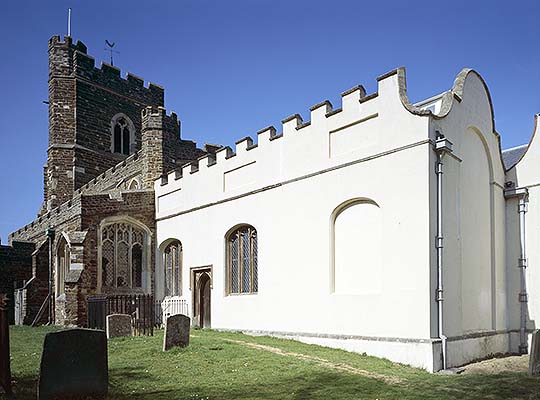Description of De Grey Mausoleum
The De Grey Mausoleum contains 17 monuments, in addition to several panels moved from the adjoining church. They make up one of the finest collections of monument effigies in England.

The Building
The original burial chamber built by Henry Grey, 6th Earl of Kent, was altered in the early 18th century with the addition of arms to the north, south and east, and a central crossing chamber to create a cruciform plan. Unusually for a mausoleum, the building is well lit, with large east-facing windows.
Further alterations were made to the southern limb of the mausoleum to accommodate the tomb of Thomas, 2nd Earl de Grey, in 1859. The external walls were rendered and the east window of the southern arm was blocked.
The Monuments
The monuments display a wide range of styles from late Gothic, Jacobean, baroque and neoclassical to the neo-Gothic. The de Grey family members buried in the mausoleum were not actually buried within the tombs, but in vaults beneath the stone floor.
The oldest monument, that of the mausoleum’s founder, Henry, is Jacobean in style. The brightly painted alabaster effigies of the earl and his wife, Mary, lie on a large tomb chest, decorated with heraldic symbols.
The finest monument in the collection is undoubtedly that of Henry Grey, 1st Duke of Kent, and his two wives, against the north wall of the east chamber. This superbly sculpted baroque monument has been attributed to the Flemish sculptor John Michael Rysbrack (1694–1770), although it is signed by the architect Edward Shepherd (d.1747 ). It shows the duke clad in Roman armour.
Henry’s children, all but two of whom died before him, are commemorated in the central and northern chambers.
Opposite Henry’s monument is the memorial erected by Jemima, Marchioness Grey, on the death in 1790 of her husband, Philip Yorke, 2nd Earl of Hardwicke. It depicts a mourning woman beside an urn, a popular neoclassical design.
The two fine monuments that conclude the series belong to Thomas, 2nd Earl de Grey, and his wife, Henrietta (d. 1848). They are quite different in style. Thomas’s monument rests on a neo-Gothic chest tomb, a conventional style for the tombs of noblemen in the later 19th century.
The monument to Henrietta is a Romantic tableau showing the earl and his children mourning at her coffin while an angel above leads her soul to heaven – a vivid display of Victorian piety and loss.
